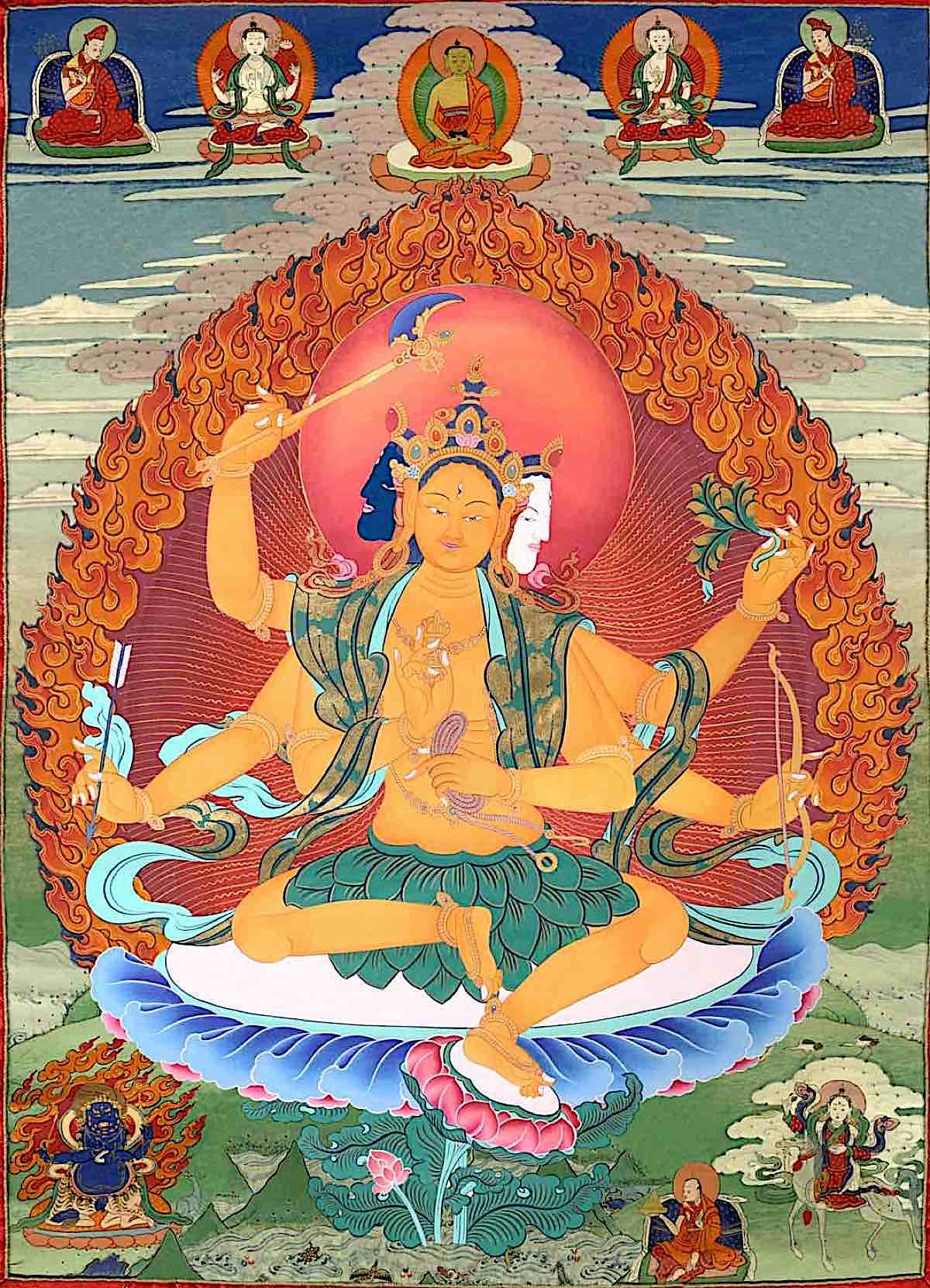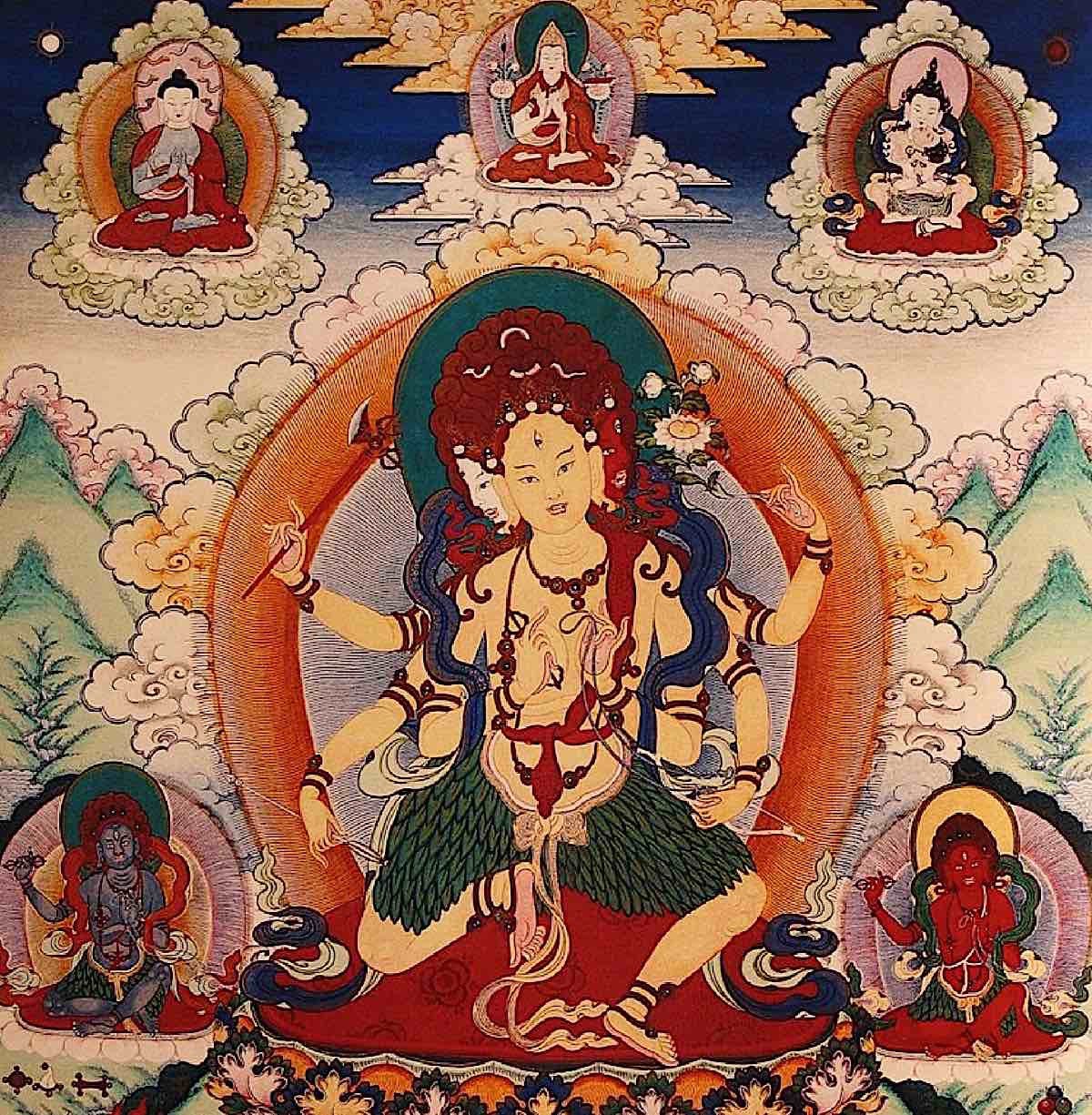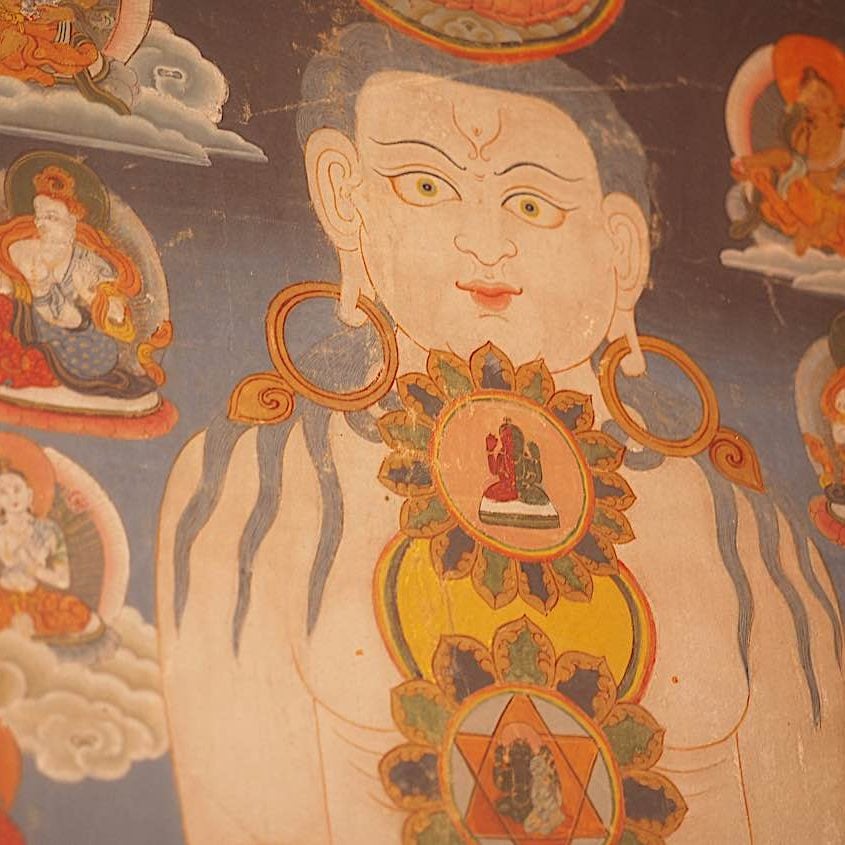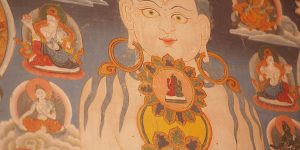Healing Parnashavari — Tara’s Healing emanation: specialist in Contagious Disease, Illness, Pandemic: How to practice her mantra and sadhana
“Tara dressed in leaves” is Parnashavari, the 20th emanation of Tara in the 21 Taras Praise.[3] Her name literally translates from Sanskrit to English as a “leaf-clad goddess” — a treasured and revered emanation of Tara relied upon to prevent or remove epidemics and contagion. (Tibetan: ri tro ma rig sum, lo ma gyun ma. English: the Mountain Ascetic – Wearing Leaves).
- A full healing sadhana and a beautiful mantra chant from the Pema Chopel Rinpoche is below.
Her practice is recommended daily in the Drikung Kyabgon during “the outbreak of the coronavirus COVID-19”:
“Since the outbreak of the coranvirus (COVID-19) continues to spread around the world I take this opportunity to ask all Drikung Kagyu monasteries, centers and disciples to practice Dakini Parnashavari and recite her mantra on a daily basis. Dakini Parnashavari is the supreme mother of all Buddhas. She manifests in this form aspiring to pacify diseases.” — HH Konchok Tenzin Kunzang Tinle Lhundrup [4]
New Video: The amazing Hrishi sings the Paranashavari Tara Healing Mantra 108 times with beautiful meditative images and animations:
Tara appears in many forms — Her ultimate nature is, in essence, the same as all Buddhas — but visualizing Her in a form specialized in disease is helpful for triggering that part of mind-body that self-heals, and connecting with the Glorious Goddess or Protection at a higher level.
Like Green Tara, Parnashavari is a “manifestation of the Compassion of all Buddhas. She is invoked to protect us from contagious diseases.” [1]

20th Tara of 21
According to the Drikung Kagya Lineage, the 20th Tara in the treasured 21 Taras praise is Parnashavari (it may vary by tradition.).
She is described as “supreme mother of all Buddhas” by Konchok Tenzin Kunzang Tinle Lhundrop of Drikung Kyabgon. [Full letter photo inset.]
In a feature by Khenmo Khochog Nyima Drolma: “Within the family of Buddhas that emphasize how to learn compassion, there are famously 21 Taras, female Buddhas. Lady Parnashavari, the dakini who is attired in green leaves of medicinal plants, is the 20th of the 21 Taras. She protects us from contagious diseases such as the Coronavirus that we have today. I find her image compelling, as unlike most deities, who are depicted in royal attire, she is clothed in medicinal plants and herbs. She carries a bow and arrow and battle axe to vanquish illness (ignorance) and medicinal plants. She sits with one leg extended, ready to jump into action, an ancient super-hero! The significance is to cultivate confidence in our own seed of wisdom and that of others by imagining a powerful accomplished example.
“Chanting mantra unites our body, speech and mind with her realization. We visualize her and all Buddhas filling the whole of space and sending healing nectar, filling the bodies of all sentient beings in every region and nation, all the bodies of water, all the vast extent of the skies.” [3]
Mantra: OM PI-SHA-TSI PARNA-SHA-WARI SARVA MA-RI PRA-SHA-MA-NI HUNG
Her Visualization
Parnashavari has other aspects, but the main deity is golden or yellow in colour with three faces and six arms. She is very active, with an “angry laugh” and golden in color to attract merits and health. She is semi-wrathful — needed to “fight” contagions.
Like other Taras she has the “one leg extended” posture — ready to leap to your aid! Each of her three faces is different colours: main face (front) is yellow, and the other two are red and green — sometimes white and red. There are also aspects of Paranashavari who are black or red. (See thangka below where to the left is black mind-Parnashavari and on the right side is red speech-Parnashavari.) In her 3 right hands, she holds a double-dorje, a club and an arrow; in her 3 lefts, a lasso, lotus and bow. She also appears as Green Parnashavari, with Amoghisiddhi Buddha on her crown, and her other two faces blue (right) and white (left.) She also has a wrathful appearance, with a protruding belly (but youthful!) clad in tiger skin loincloth and leaves.

This is a full description of the above Parnashavari’s thangka from Himilayan Art
“Natural in colour (yellow), she has three faces and six hands. The main face is slightly peaceful and wrathful with three eyes and the hair tied with a snake in a topknot on the crown of the head. The red face on the left is in a desirous mood and the white face on the right is peaceful. The first pair of hands hold a gold vajra and a vajra lasso held to the heart. In the second pair is a vajra axe upraised in a manner of striking and a fan of fresh leaves and in the lower pair of hands is an arrow and bow. Adorned with gold and jewel ornaments, a circlet of fresh leaves around the neck and a long snake necklace she wears an upper silk scarf gray in colour. The lower body is covered with a thatched skirt of fresh leaves tied with a yellow silk ribbon. With the right knee pressing on the sun disc and lotus seat she sits in a kneeling posture. A dark green aureola frames the faces and a blue-pink nimbus surrounds the entire form.”

“At the top center is the Gelug founder Tsongkapa. To the left is Nageshvara Raja Buddha. On the right side is Heruka Vajrasattva. The central figure is Body-Parnashavari, yellow in colour. To the left is black mind-Parnashavari and on the right side is red speech-Parnashavari.”
From Khandronet: “Some of Parnashawari’s other epithets are: Sarvamariri-prashamani — healer of all epidemic diseases, and Sarvashavaranam Bhagavati = Lady / Goddess, Healer of the Shavari.”
Healing Mantra
The healing mantra — a pacifying mantra — is open to all to practice, as with many of Tara’s forms:
OM PI-SA-CHI / PAR-NA-SHA-VA-RI / SAR-VA ZO-LA / PRA-SHAMA- NA YE SO-HA
This is also written in as: Om Pishachi Parnashavari Sarvajora Prashamanayeh Soha
Although it should not be chanted in English, here is a rough translation of the mantra:
{Om, Recluse(the female holy one who is) clad in leaves, let the foundation be laid (for peace, stability and prosperity) by completely and instantly eliminating all deadly epidemics, svaha.}
Please view and meditate on the beautiful video/chant from Pema Chopel Rinpoche below. Play it and chant it and meditate on healing:
From Rangjunt Yeshe Institute:

“This is a mantra of pacifying (one of the four types of activity).
· sarva means “all”.
· śamanī (feminine) means “one who pacifies”. The prefix pra strengthens or intensifies the meaning of pacifying, and upa could suggest that this pacifying is somehow rendered as a personal help. (upa implies near and ready, on stand-by)
· śavarī (feminine) is a tribal woman, considered to be low caste or outcaste, even barbarian.
· parṇa means “leaves”, so parṇaśavarī suggests a tribal woman who wears a skirt of leaves (this goddess is iconographically depicted as wearing leaves).
· piśācī (feminine) is a spirit from the piśāca class.
· svāhā is a benediction that typically comes at the end of peaceful mantras.
The words all have a vocative ending (short i instead of long), which means that the mantra addresses Parṇaśavarī directly, in the second person.”
Parnashavari Protection Wheel
Parnashavari’s Protection Wheel is considered powerful protection — either visualized during the sadhana, or as a printed out “protection.” (See inset.)
Healing Sadhana Parnashavari
Logyunma / A Practice of Parnashavari
Prayer Recitations to Overcome Diseases and Epidemics
Refuge and Bodhicitta
In Buddha, Dharma and Supreme Sangha
I Take refuge until full enlightenment is reached
Through perfecting the deeds of generosity and others
May I attain Buddhahood for the benefit of all sentient beings [3x]
The Four Immeasurable
May all sentient beings have happiness and the cause of happiness
May all sentient beings be free from suffering and the cause of suffering May all sentient beings never be separated from the happiness that is sorrowless
May all sentient beings, near and far away, live in the state of equanimity, free from attachment and hatred
Praise to Revered Parnashavari
I pay homage to the goddess who is an illusory emanation of the primordial wisdom of all the victorious ones; she who completely removes all inner demons and obstacles.
Mantra Recitation
OM PI-SA-CHI / PAR-NA-SHA-VA-RI / SAR-VA ZO-LA / PRA-SHAMA- NA YE SO-HA
(Repeat many times. Refer to video for pronunciation.)
Rough Translation (do not speak, for reference)
{Om, Recluse(the female holy one who is) clad in leaves, let the foundation be laid (for peace, stability and prosperity) by completely and instantly eliminating all deadly epidemics, svaha.}
Dedication
By the merit of this may all sentient beings as infinite as space Attain the state of vajradhara swiftly in one life-time
through perfecting the two accumulations of merit and wisdomMay beings everywhere who suffer from mental and physical pain have by virtue of my merits
Joy and physical happiness in boundless measure like the oceanMay every being ailing with disease
be freed at once from every malady
may all the sicknesses that afflict the living not occur forever.
This prayer is taken from Sakya Tharpa Ling, Brisbane May 2003, during the visit of H.H Sakya Trizin.
[2]
NOTES
[1] Tara Dressed in Leaves page on Khandro Net
[2] From A Collection of Healing Methods by Jason Espada.
[3] Vajra Dakini Nunnery “She Who Vanquishes Epidemics” Lady Parnashavari (Drikung Kagyu Lineage)
[4] From Garchen.net. “Covid-19 practices”
More articles by this author

Buddhist body mandala practice in Vajrayana Buddhism — and riding the winds of the inner body “The prana goes where the mind goes.””
Search
Latest Features
Please support the "Spread the Dharma" mission as one of our heroic Dharma Supporting Members, or with a one-time donation.
Please Help Support the “Spread the Dharma” Mission!

Be a part of the noble mission as a supporting member or a patron, or a volunteer contributor of content.
The power of Dharma to help sentient beings, in part, lies in ensuring access to Buddha’s precious Dharma — the mission of Buddha Weekly. We can’t do it without you!
A non-profit association since 2007, Buddha Weekly published many feature articles, videos, and, podcasts. Please consider supporting the mission to preserve and “Spread the Dharma." Your support as either a patron or a supporting member helps defray the high costs of producing quality Dharma content. Thank you! Learn more here, or become one of our super karma heroes on Patreon.
Lee Kane
Author | Buddha Weekly
Lee Kane is the editor of Buddha Weekly, since 2007. His main focuses as a writer are mindfulness techniques, meditation, Dharma and Sutra commentaries, Buddhist practices, international perspectives and traditions, Vajrayana, Mahayana, Zen. He also covers various events.
Lee also contributes as a writer to various other online magazines and blogs.


















